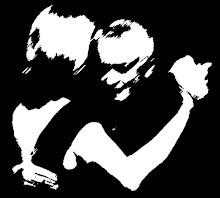A: "There she is. She's a beginner - she needs some advice. I'll give her the benefit of my expertise. After all, she'll feel grateful that someone with my experience is getting her up to dance."
(Why do some people feel the need to do this??)
B: "I was pushed and pulled all over the place. He was showing off, trying to get me to do his tricks. I had no idea what he wanted me to do, and I was made to feel like an idiot with everyone watching. He was in my ear all the time, telling me what to do - I couldn't focus on the music. Then, he used the breaks in the tanda to demonstrate figures to me. I'm new to tango and simply didn't know how to deal with the situation. I love the music, the dance, the connection, but after that, I just felt like going home."
Of course, there's an equivalent scenario with the roles reversed.
The fundamental element missing above is
RESPECT. A good tango dancer (not necessarily one with lots of years of experience) will respect his/her partner - won't give unsolicited advice in the milonga, and will dance in a manner that is appropriate to the partner's current ability. The good dancer will, in fact, be able to enhance his/her partner's dancing as the tanda progresses. Yes, we may want to give our partner the benefit of our expertise, but that can be achieved through
HOW we dance with them.
A good male dancer, for example, will start the tanda with a new partner by walking with sensitivity to the music - monitoring his partner's responses and accommodating, in order to instil confidence. Then maybe some small backward ochos, taking time to ensure that she completes her pivot before the next step, and being very explicit with the leads. The focus is on his partner, ensuring that she is comfortable and that the communication is working. Above all, a good dancer will respond to the music so she
FEELS it through his body and his movements. During the tanda he'll check that she's feeling OK. You may ask: What about him? Well, this tanda is all about
HER, as he does his best to convince her that tango is a dance of love - in many aspects.
So, how could a beginner deal with the humiliating treatment described earlier? She doesn't want to be labelled a snob by turning men away, thereby possibly reducing the chances of men inviting her to dance. On the other hand, she doesn't want to feel like someone's plaything.
Think of it this way: when it comes to unwelcome behaviours, tango is no different to other social situations. If she doesn't like what's happening to her, she doesn't have to put up with it. She could say something like:
- "I'm sorry, but I don't feel comfortable with this right now. I'd rather sit down."
- "I'm really not able to talk and dance at the same time."
- "Thanks, but I need to sit down."
And in future, it's best to avoid the situation by actively using the
cabeceo, and avoiding the gaze of certain people. It also pays to be armed with a response for unwelcome direct approaches - commonly used on beginners. If you'd rather not dance with someone, try something simple like: "Thanks, but not right now."
BTW. What do I mean by a 'good tango dancer'?
Someone who respects his/her partner and strives to make the tanda a positive experience; understands and practises the codes of the milonga; feels, connects with, and expresses the music in his/her dancing, and has the skills to execute tango movements which are appropriate in the social, sometimes crowded, context.
So, in the opening scenario, could you spot the real beginner?
Bob



